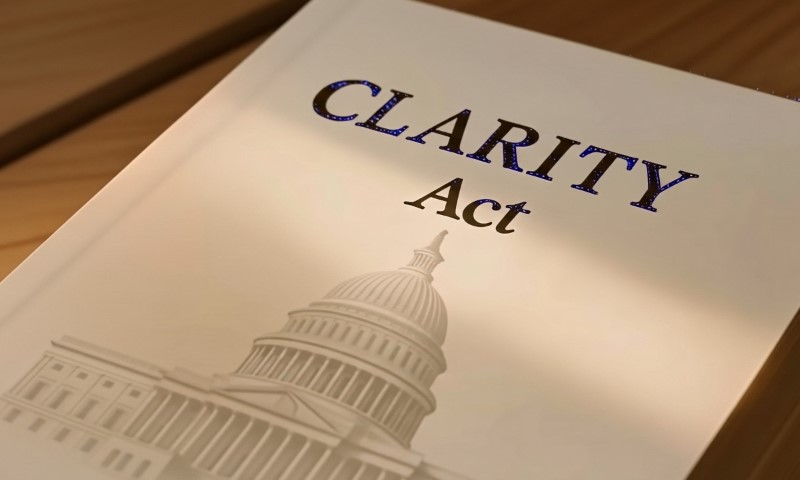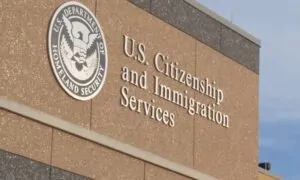The Digital Asset Market Clarity Act of 2025, known as the CLARITY Act, is a structural reorganization of who does what in U.S. digital asset oversight.
Passed by the House on July 17, 2025, with a 294-134 bipartisan vote, and sent to the Senate two months later, the proposal reshapes the regulatory center of gravity around the Commodity Futures Trading Commission while keeping the Securities and Exchange Commission’s hand on fundraising and investor protection.
What unfolds next in the Senate could determine whether the U.S. finally gets a unified digital-asset framework or faces another year of fragmented jurisdiction and hesitant innovation.
Table of Contents
ToggleKey Highlights
- The CLARITY Act shifts digital asset trading oversight to the CFTC while keeping fundraising under SEC control.
- It introduces a “mature blockchain” test defining when projects qualify for lighter regulation.
- Exchanges must meet strict custody, transparency, and anti-fraud standards under CFTC rules.
- Stablecoins are excluded, governed separately under the GENIUS Act framework.
Why the CLARITY Act Exists
The bill answers years of market confusion about what counts as a “digital commodity” versus a “security.”
For retail investors buying popular assets like Bitcoin through Changelly or similar platforms, the lack of consistent classification has often caused compliance uncertainty.
For years, issuers and exchanges have operated under overlapping SEC and CFTC interpretations, often learning the rules through enforcement rather than statute.
The CLARITY Act changes that equation by defining core categories, assigning regulators, and formalizing compliance paths that encourage decentralization and transparency.
Core Purpose
The CLARITY Act rebalances power between the two agencies that have long shared an uneasy relationship over crypto: the SEC and the CFTC.
It draws a bright line between fundraising and primary issuance (which stays under SEC control) and trading of digital commodities (which moves squarely to the CFTC).
How It Splits Jurisdiction
| Area | Lead Regulator | Key Features |
|---|---|---|
| Primary fundraising | SEC | Limited registration exemption tied to blockchain maturity |
| Spot digital commodity trading | CFTC | Mandatory registration and Core Principles for exchanges, brokers, and dealers |
| Stablecoins | Separate Senate bill | Explicitly excluded from CLARITY scope |
| DeFi oversight | Ongoing Senate negotiations | Possible inclusion in future legislation |
That division gives market participants a reference map for the first time. Instead of guessing who will knock on the door, companies can structure compliance around two agencies with defined mandates.
What Counts as a “Digital Commodity”

The bill defines a digital commodity as any asset whose value is inherently linked to the use and function of a blockchain.
In practice, that means tokens that operate as part of a decentralized protocol or network rather than as investment contracts or stable-value instruments.
Explicit Exclusions
- Securities remain under SEC jurisdiction.
- Derivatives continue under existing CFTC frameworks.
- Stablecoins are carved out, with oversight governed by the separate GENIUS Act passed earlier in the Senate.
That separation prevents duplication of enforcement and avoids reopening the stablecoin reserve debate already settled in another legislative vehicle.
The “Mature Blockchain” Gate
One of the CLARITY Act’s more innovative ideas is the “maturity” test. It defines when a blockchain has reached sufficient decentralization and governance independence to qualify for lighter regulatory treatment.
Maturity Criteria Include
- Dispersed token ownership and governance participation
- No privileged rights for developers or insiders
- Publicly verifiable code and transparent updates
- Functional independence from any single control group
Issuers can self-certify a chain as mature, but the SEC must validate that claim. If the SEC disagrees, the issuer can pursue “intended-to-mature” status, a transitional category that allows limited fundraising while the network decentralizes.
This concept effectively codifies what used to be informal guidance: projects can earn regulatory freedom by relinquishing control.
Fundraising On-Ramp

The CLARITY Act grants a narrow exemption from full SEC registration for fundraising tied to mature or maturing blockchains.
It gives teams a compliant way to raise money without treating every sale as a securities offering.
Exemption Requirements
- Sales cap: A fixed dollar limit on total fundraising over a 12-month period.
- Offering statement: Public filing with project disclosures, risk factors, and maturity details.
- Ongoing reporting: Continued updates for chains that have not yet achieved maturity.
- Timeline accountability: The SEC must issue rules within 270 days for projects that fail to reach maturity within the expected period.
The structure blends investor protection with practical flexibility; projects can raise funds transparently without a multi-year registration process that doesn’t fit decentralized ecosystems.
The CFTC’s New Role
The CLARITY Act’s heart lies in the CFTC’s expanded jurisdiction. Once enacted, the agency would become the primary regulator of digital commodity trading platforms, brokers, and dealers.
Mandatory Registration and Core Principles
Registered entities must meet a compliance stack modeled after futures-market standards:
- Trade surveillance and recordkeeping
- Conflict-of-interest policies
- Market integrity and antitrust controls
- Custody segregation rules prohibiting commingling of customer assets
- Proprietary trading limits for exchanges and affiliates
The bill also modernizes bankruptcy treatment for customer property at digital commodity venues, closing gaps that left FTX-style collapses ambiguous under current law.
Listing Standards and Code Transparency

Every registered platform must verify that listed assets are either:
- Digital commodities on mature blockchains, or
- Assets whose issuers publish detailed, ongoing disclosures if the chain is not mature.
Before a token can trade, the exchange must publish:
- Source code repository and version history
- Transaction and block history
- Economic model (tokenomics)
- Governance framework
The CFTC may disapprove a listing, but only with a detailed public explanation. This creates a transparent record that raises the bar for listing integrity and cuts down on insider token launches or stealth economics.
Provisional Registration
To avoid regulatory shock, the CLARITY Act creates a provisional registration path. Firms that apply early and meet baseline standards can continue operating while the CFTC finalizes permanent rules.
Conditions include:
- Maintaining asset-protection controls
- Granting regulators full access to books and records
- Paying a temporary registration fee that sunsets after four years
That transitional system prevents market paralysis while signaling that provisional status is temporary, not a long-term loophole.
Custody, AML, and Stablecoin Boundaries
The bill expands Bank Secrecy Act coverage to every newly registered exchange, broker, and dealer, locking in anti-money-laundering and counterterrorist-financing obligations.
It also introduces a qualified custodian standard, aligning digital asset custody with established banking and trust frameworks. Banks, state-regulated trusts, and approved custodians can hold digital commodities under defined safeguards.
Stablecoins, however, remain outside the scope. By excluding them from the “digital commodity” definition, the CLARITY Act ensures consistency with the Senate’s separate GENIUS Act, which already defines stablecoin reserve and disclosure requirements.
Where the Bill Stands in the Senate
The CLARITY Act reached the Senate Banking, Housing, and Urban Affairs Committee on September 18, 2025. Its path forward depends on how the chamber handles overlapping market-structure negotiations.
Current Environment
- Stablecoin framework passed: The GENIUS Act cleared the Senate in June 2025.
- DeFi debate underway: Senate Democrats are pushing new rules for decentralized interfaces and front ends.
- Negotiations slowed: Disputes over language tied to exchange reward programs and anti–money-laundering clauses have delayed markup sessions.
- Industry engagement active: Crypto executives and trade associations are meeting with Senate offices to shape definitions and timelines.
The committee could choose to mark up H.R. 3633 directly, merge it with a broader market-structure bill, or delay until 2026 if the calendar tightens.
What Changes If the CLARITY Act Passes
If the CLARITY Act becomes law, the digital asset industry would operate under a new power map where the CFTC takes charge of trading markets, the SEC manages fundraising, and both agencies finally have clear boundaries.
CFTC Becomes the Central Examiner
CFTC exam teams would oversee the day-to-day operations of registered exchanges, brokers, and dealers. Expect futures-style supervision:
- Surveillance of wash trading and spoofing
- Controls for insider conflicts
- Transparency in order books and code updates
- Enforcement consistency across centralized markets
Fundraising Incentives Shift Toward Decentralization
Developers have a measurable reason to decentralize governance and distribution. The faster a project reaches maturity, the sooner it can raise capital under the SEC exemption.
Those that fail to decentralize face higher disclosure burdens and potential restrictions. Governance audits and concentration analysis will likely become standard steps before any certification of maturity.
Listing Becomes a Disclosure Exercise, Not a Gamble
Instead of opaque token listings, exchanges must publish comparable technical and economic data. Investors, regulators, and auditors can review standardized documents before trading begins.
That change makes due diligence more predictable and reduces asymmetry between insiders and retail participants. It also gives compliant platforms an advantage over informal venues that can’t meet disclosure requirements.
Stronger Custody and Segregation Norms
Commingling customer assets, a core issue in past exchange failures, would be outright prohibited. Custody must meet qualified custodian standards, verified through audits and periodic reporting.
Proprietary trading by exchanges would be heavily restricted, restoring a clean divide between operators and participants. For institutional entrants: banks, trust companies, and broker-dealers, this framework reduces legal uncertainty and invites participation.
Industry Impact by Segment

Different sectors would feel the CLARITY Act in distinct ways. Each faces new compliance duties, operational shifts, and strategic opportunities.
Centralized Exchanges
Platforms with robust compliance systems and transparent governance stand to gain the most. CFTC registration legitimizes their operations and creates a national licensing path.
Smaller or offshore exchanges may struggle to meet Core Principles, especially around surveillance and custody segregation. Proprietary trading limits also narrow the scope for vertically integrated models.
Token Issuers and Protocol Foundations
Issuers that can credibly demonstrate decentralization gain access to a lawful fundraising mechanism.
The maturity gate will require measurable metrics: dispersed token ownership, public governance records, and audited code releases.
Foundations will likely publish annual “decentralization audits” documenting governance changes, ownership statistics, and protocol control thresholds. Treasury dispersal and vesting redesigns could become standard to meet maturity criteria.
Traditional Finance
The CLARITY Act opens a path for traditional institutions to enter digital markets without regulatory whiplash.
Broker-dealers can trade digital commodities through Alternative Trading Systems (ATSs) if both the SEC and CFTC coordinate conditions.
DeFi Builders
While decentralized validation remains outside the registration scope, the bill preserves anti-fraud and anti-manipulation authority for all market participants.
That means DeFi developers are not automatically exempt from enforcement if their protocols enable illicit behavior.
A separate DeFi bill under discussion could add direct reporting or registration requirements for front-end operators and routing services, which would extend compliance expectations deeper into the decentralized stack.
Practical Steps for 2025 Market Participants

Market participants can start preparing now. The following actions outline how exchanges, issuers, and institutions can align with the CLARITY framework before final rules take effect.
For Exchanges and Brokers
- Map existing surveillance systems to the CFTC Core Principles.
- Implement asset segregation with independent attestations.
- Build listing templates covering code, governance, and token economics.
- Train compliance staff on trade surveillance and reporting procedures.
For Issuers and Foundations
- Develop a documented decentralization roadmap with clear milestones.
- Structure token distributions to prevent concentration beyond statutory caps.
- Prepare offering statements and maturity disclosures for SEC review.
- Establish third-party verification for governance dispersion metrics.
For Broker-Dealers and ATS Operators
- Identify eligible digital commodities that meet CFTC listing standards.
- Align custody, reporting, and recordkeeping with SEC and CFTC rules.
- Coordinate filings to prevent dual-jurisdiction conflicts.
For Banks and Custodians
- Review eligibility under qualified custodian criteria.
- Align asset-control procedures with OCC or state trust requirements.
- Integrate anti–money-laundering systems across digital and fiat operations.
For Stablecoin Issuers
- Follow the GENIUS Act framework on reserves, attestations, and transmission.
- Keep operational boundaries clear between stablecoin activities and digital commodity trading platforms.
Key Numbers and Deadlines
| Metric | Value / Date | Description |
|---|---|---|
| House passage | 294–134 | Bipartisan vote on July 17, 2025 |
| Senate referral | September 18, 2025 | Sent to Banking, Housing, and Urban Affairs Committee |
| SEC rulemaking deadline | 270 days post-enactment | Rules for chains that fail to mature |
| Provisional registration fee sunset | 4 years | Temporary regime expires automatically |
Where Policy Analysts Stand
Congressional Research Service assessments frame the bill as a CFTC-first model: digital commodity trading under futures-style rules, SEC oversight limited to primary issuance, and a formal decentralization test for blockchain maturity.
Legal commentators describe Senate action as intertwined with broader market-structure talks. The most likely outcomes include:
- Clean Senate passage of H.R. 3633 with technical amendments.
- Inclusion in a consolidated market-structure package combining CFTC and SEC reforms.
- Deferral to 2026 if the legislative calendar tightens or negotiations stall.
Each scenario yields roughly the same CFTC registration regime but could alter how maturity certifications and DeFi oversight take shape.
The Broader Implication
If enacted, the CLARITY Act would mark the first comprehensive digital-asset framework in U.S. federal law. It pulls spot digital commodities into a regulated domain without labeling every token a security, while giving developers a predictable roadmap to decentralization and lawful fundraising.
Stablecoins continue under the GENIUS Act track, and DeFi oversight may evolve through separate bills. But for exchanges, brokers, and foundations, the message is clear: the U.S. is formalizing the rules of engagement.
The result would be a CFTC-led ecosystem where transparency, custody integrity, and decentralization are no longer optional, but table stakes.
Related Posts:
- SEC Allows Public Companies to Push Shareholder…
- What You Need To Know About the Equality Act in 2025
- Safest Countries in the World in 2025 - GPI…
- America's Murder Capitals: A 2025 Ranking of the…
- Capital Cities in Europe: Top Destinations For You…
- Legislative Tracker: Pro-LGBTQ Nondiscrimination Legislation








